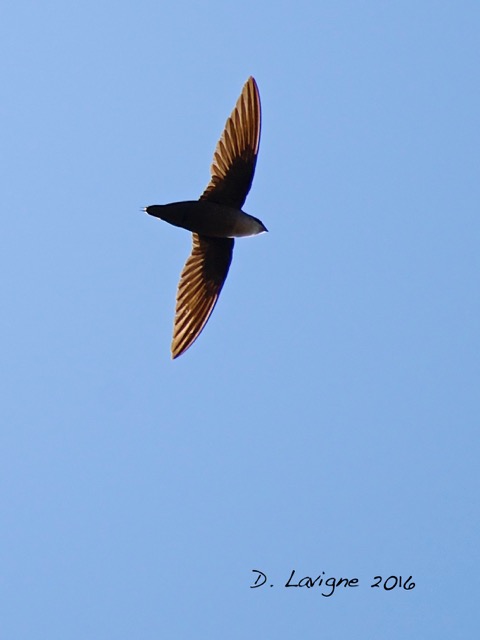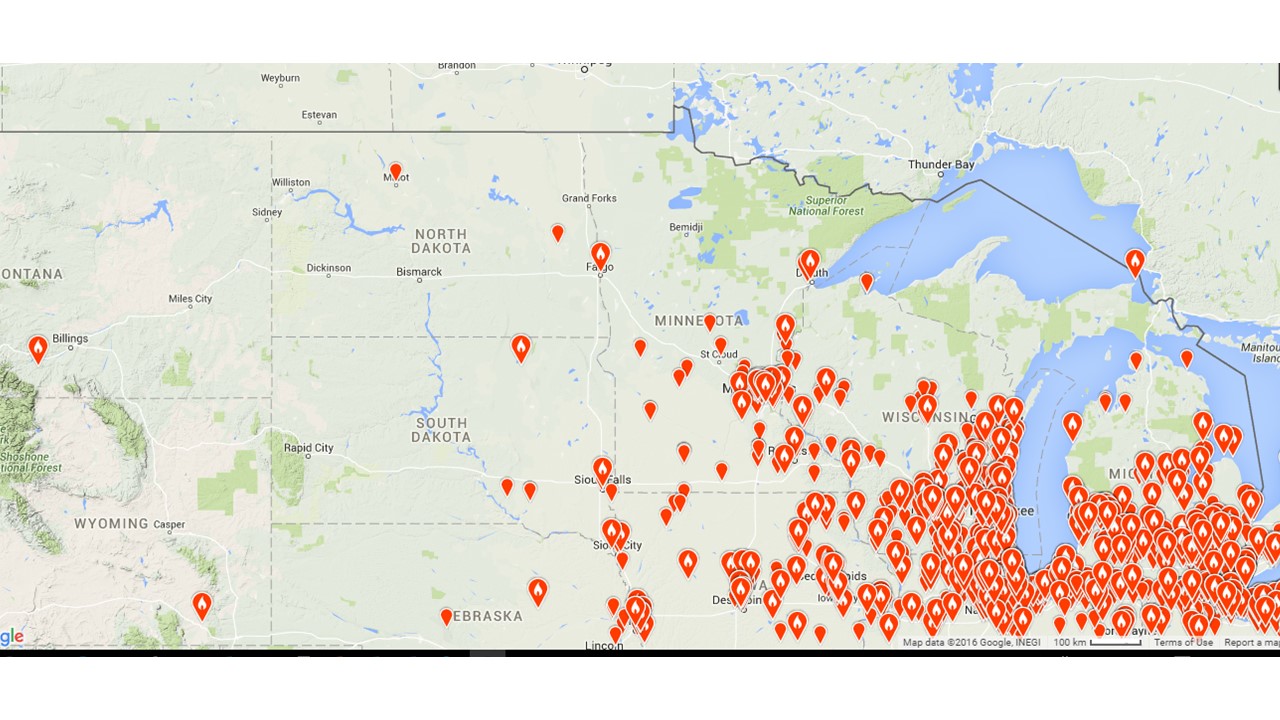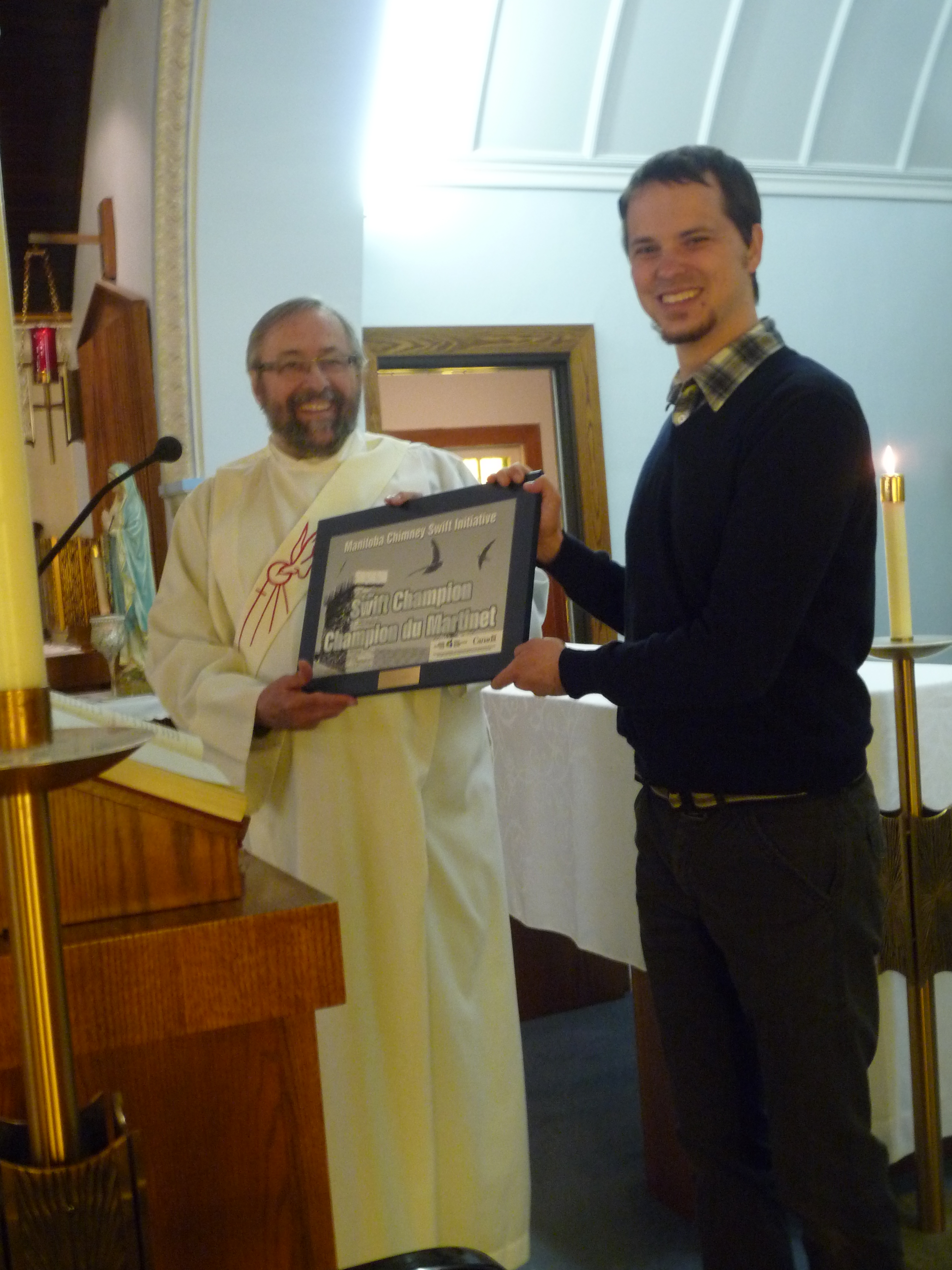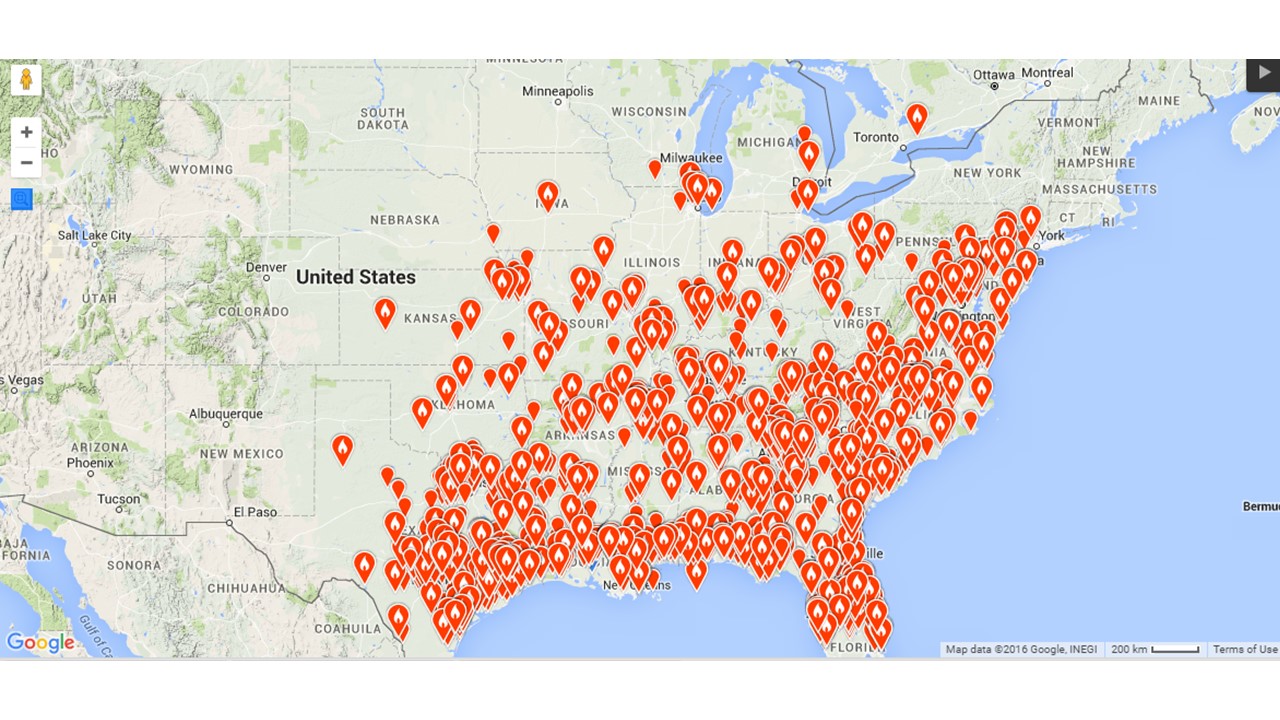The following video clip (5 sceonds) was made at the Assiniboine School in Winnipeg on the evening of May 28, 2016.
Thanks to Luke Roffey for taking the video on his smartphone.
Click to see the video on YouTube
The following video clip (5 sceonds) was made at the Assiniboine School in Winnipeg on the evening of May 28, 2016.
Thanks to Luke Roffey for taking the video on his smartphone.
Click to see the video on YouTube

As we head towards the FINAL NIGHT for the 2016 National Roost Monitoring Program (NRMP) session on MONDAY, JUNE 6, we have an update of the NRMP-3 results and reports of Chimney Swifts monitoring done before, and in-between, the NRMP nights. Here is what happened:
 THANKS everyone for participating in the national initiative! All the best for the NRMP season finale on Monday, June 6th. Here are a few things to think about as you stare at the chimney rim:
THANKS everyone for participating in the national initiative! All the best for the NRMP season finale on Monday, June 6th. Here are a few things to think about as you stare at the chimney rim: Our update starts with a special shoutout to Gord and Louise who made a special recon trip to Estevan, SK. Gord is an experienced monitor who can spot swifts, hear swifts, and pick out potential sites with ease. After the 4.5 hour trip from Portage La Prairie, 5 Chimney Swifts obliged with an appearance over Main St., Estevan. The birds were flying quite low for mid-day. Six potential roost/nest sites were identified and the information has been passed along to Becky Magnus, the acting coordinator of SCSI (rmagnus@naturesask.ca). Chimney Swifts in the prairie provinces are well served by Gord and Louise’s activities – thanks for all you do! If anyone can provide historical or recent information about Saskatchewan Chimney Swifts, get in touch with Becky.
Our update starts with a special shoutout to Gord and Louise who made a special recon trip to Estevan, SK. Gord is an experienced monitor who can spot swifts, hear swifts, and pick out potential sites with ease. After the 4.5 hour trip from Portage La Prairie, 5 Chimney Swifts obliged with an appearance over Main St., Estevan. The birds were flying quite low for mid-day. Six potential roost/nest sites were identified and the information has been passed along to Becky Magnus, the acting coordinator of SCSI (rmagnus@naturesask.ca). Chimney Swifts in the prairie provinces are well served by Gord and Louise’s activities – thanks for all you do! If anyone can provide historical or recent information about Saskatchewan Chimney Swifts, get in touch with Becky.
Back in Manitoba, we have had a lot of reports for May outside of the NRMP dates. Here is a summary of opportunistic observations and monitoring reports:
MCSI is fortunate to have returning volunteers and new monitors observing many chimneys. NRMP-2 weather was very obliging and a lot of early reports have come in:
-SE Club Amical = 0; NE Club Amical = 2 – Kathy and Rob were onsite.
-Brodeur Bros. = 0; Jacquie and Roberta noted an entry/exit which seemed to be a swift checking out the chimney quickly.
-Church = 3 ; Lewis and Ken helped Frank break the curse of never seeing the most Chimney Swifts in one night (a good omen for ’16!)
-Main St = 1; Barb is hopeful that a local redistribution of swifts will result in a breeding pair taking up residence.
.
-Winona note 3 roosting birds at the Merchants Hotel.
-Gerald saw 2 swifts at 241 Manitoba Ave.
-Robert recorded 2 entries at the Infirmary Chimney.
-Carol, Bonnie, and Gerald saw 1 entry at the Yellow Brick site.
Carol, Bonnie, and Gerald also had a direct view of the Large Stack where 25 entries and 3 exits occurred. When you adjust for exits made during the monitoring session, a total of 22 swifts roosted for the night. Interestingly, the NRMP-1 total was 33 in only the large stack and NRMP-2 total = 30 in town. Some dispersal – locally and beyond – seemed to have taken place between May 25 and 29.
 The weather has not established a positive cadence yet. Cold, rainy weather enveloped the province again after NRMP-2 and is persisting through June 1. The promise of a sunny night for NRMP-3 THURSDAY, JUNE 2 is with us though. Dauphin, Brandon, Portage La Prairie, Pine Falls, Steinbach, and Winnipeg areas will emerge as a sunny day after a cold, wet night. It will be interesting to see if migrants have been arriving during this challenging feeding weather and how Chimney Swifts are partitioning themselves at nest sites…
The weather has not established a positive cadence yet. Cold, rainy weather enveloped the province again after NRMP-2 and is persisting through June 1. The promise of a sunny night for NRMP-3 THURSDAY, JUNE 2 is with us though. Dauphin, Brandon, Portage La Prairie, Pine Falls, Steinbach, and Winnipeg areas will emerge as a sunny day after a cold, wet night. It will be interesting to see if migrants have been arriving during this challenging feeding weather and how Chimney Swifts are partitioning themselves at nest sites…
READ ALL ABOUT IT! In case you missed the article in last weekend’s Free Press, you might want to check In Conversation with Tim Poole
We look forward to hearing from you after Thursday night’s session,
Barb for the MCSI team: webmaster – Frank Machovec; Habitat Stewardship and Outreach Coordinator – Tim Poole; Steering Committee Members – Christian Artuso, Ron Bazin, Neil Butchard, Lewis Cocks, Ken De Smet, Nicole Firlotte, and Rob Stewart.
REPORT FOR NRMP-1 (MAY 25) + REMINDER FOR NRMP-2 = MAY 29
 The first national monitoring night for 2016 collided with a major weather system that kept dumping rain down in most of Manitoba. We were fortunate to have hearty volunteers who toughed out the evening to generate a fascinating dataset!
The first national monitoring night for 2016 collided with a major weather system that kept dumping rain down in most of Manitoba. We were fortunate to have hearty volunteers who toughed out the evening to generate a fascinating dataset!
A warm welcome is extended to Beth who joins the Assiniboine School (St. James, Winnipeg) monitoring team. “I don’t dissolve in the rain” was last heard from Beth. True to form, clad in two layers of rain wear and sporting a waterproof bag/paper, she knocked on David’s door to usher him to the chimney side. It turned out to be an amazing experience – over 156 Chimney Swifts funneled into the roost! As background, there had been close to 4 straight hours of moderate rain and the temperature had sunk to ~14 C when the birds entered between 8:48 – 9:01 PM; sunset was 9:21 PM.
Up in Dauphin, Ken was on stand at his roost site – rain had stopped about 2 hours before the monitoring session began. The final head count = 29 Chimney Swifts.
At a somewhat lower latitude, in Selkirk, Carol and Dorothy had 33 Chimney Swifts roost at the large stack and 0 entered the yellow chimney which is in a direct sight-line from the large stack.
Now here is where the story gets interesting…
Also in Selkirk, Gerald and James, saw 0 swifts while monitoring the infirmary chimney. This site was first discovered in 2014 and had 10 swifts using it; in 2015, 3 swifts were observed.
Tim, in Fort Rouge, saw 0 swifts around the Leisure Centre on the west side of Osborne. This chimney was a possible nest site in 2015 and was used by 2 swifts.
Jim, in Fort Rouge, saw 0 swifts around Beresford on the east side of Osborne St. He noted Chimney Swifts tearing around the area on May 24 and May 26. In 2015, Quinn monitored this site and it was used by 2-4 swifts before a nesting attempt appeared to be abandoned in early June.
Out in La Broquerie, David saw – yes – 0 swifts around the church. In 2015, a breeding pair successfully fledged young at this nest site.
So a pattern seemed to appear with this admittedly small sample size. Large numbers of swifts entered the “big three” roost sites – the three sites which house the largest known groups of Chimney Swifts in Manitoba. At other sites which typically house smaller group sizes of roosting swifts, and at nest sites, no birds were seen at all.
What does this all mean? My working hypothesis is that the energy budgets of non-breeding and breeding Chimney Swifts drive them to behave differently under some conditions. And we had those conditions Wednesday night. If a bird can rely on the thermal advantage of huddling with dozens of other swifts, surviving the night is possible, even if it toughs out feeding in a storm longer (feeding is more difficult when the heavy rains wash the aerial prey out of the air). However, if your breeding partner is the only source of extra warmth, it would be a better “choice” to save precious calories and call it a day earlier. It is likely that breeding adults were in some nest sites well before the start of monitoring. Barn Swallows nesting on the side of our home near St. Adolphe tucked in for the night ~ 8 PM Wednesday night!
 The forecast for NRMP-2, Sunday May 29, is improving – Brandon can expect sun; La Broquerie has 30% chance of showers; Portage La Prairie, Dauphin and Winnipeg have 60% of showers…so I hope that everyone can get out without being drenched and enjoy counting Chimney Swifts.
The forecast for NRMP-2, Sunday May 29, is improving – Brandon can expect sun; La Broquerie has 30% chance of showers; Portage La Prairie, Dauphin and Winnipeg have 60% of showers…so I hope that everyone can get out without being drenched and enjoy counting Chimney Swifts.
Thanks for all of your monitoring efforts and early returns.
Let’s stay in touch, Barb.
 Reports of Chimney Swifts returning to Manitoba have come in over the past week. Here’s a recap of spring arrivals:
Reports of Chimney Swifts returning to Manitoba have come in over the past week. Here’s a recap of spring arrivals:
1. Gary B. was the first to send in a report on Sunday, May 15 – in the morning he saw 4 Chimney Swifts at Bunn’s Creek Pond, at Gateway Road, Winnipeg.
2. However, the first sighting of the year goes to Matt D. in Carman – a lone swift flew over the Elementary School early afternoon on Wednesday, May 11. I hope this is a special sign of good things to follow as Matt spent all of last summer diligently watching empty sky!
3. On May 16, Lewis C. sent news that 12 Chimney Swifts were “whirling about Fort Whyte Alive” in the morning.
4. In St. Adolphe, 2 swifts made a fleeting appearance at 7:35 PM on May 17. They fed low over Japanese Maples and flew quietly east of the cemetery. Suzanne L., a local resident, first heard characteristic Chimney Swift vocalizations ~ 5 PM.
5. Carolyn E. also heard swifts in the Hampton St., St James, Winnipeg, area on May 18.
6. The Birds and Birding in Manitoba Yahoo site had a posting by Peter Douglas on May 18: 15 – 20 Chimney Swifts had roosted in Assiniboine School, St. James, Winnipeg. The big roost appears to be setting up again this year; the roosting “funnel” is quite a spectacle to see if the numbers build.
7. Another May 18 sighting was made – this one in Portage La Prairie by Cody R. (Yahoo site posting): “Around 8 PM last night 4 chsw did a couple of flybys over my house on Dufferin ave for the first time this year”.
8. The trend of first sightings continued on May 19. Gerald M. had posted a report on the Yahoo site that the first swift had been spotted in Selkirk.
9. Perhaps you have heard my pep talk about the value of data points = 0. Observations of “nothing” establish baselines or confirm lack of activity. David D. monitored the La Broquerie Church on May 19 and saw no swifts = the birds had not returned yet. Hopefully, the season will be underway this coming week!
10. Interestingly, way up in Dauphin on May 19, Ken W. reported 10 Chimney Swifts entered their roost between 9:50-9:59 PM (sunset that night = 9:35).
More updates came in…..
Gordon O., our long term monitor in Portage La Prairie, called in a report of 2 swifts seen over Trinity United Church the morning of May 21.
When I went to St. Adolphe around 8 PM on May 21, the local group size had increased to 4.
May 22, from Ken: “still 10 swifts in Dauphin, going down between 9:50 and 9:59”
May 22, from an understandably delighted Carolyn: “A total of 6 have returned now to Hampton Street! So exciting! The watch continues! ”
The last report of a first sighting for 2016 came to our coordinator, Tim Poole, from Joel K. in The Pas. Four Chimney Swifts were flying about the rooftop at the corner of 5th Street and Larose Avenue at 7:14 AM.
Thanks everyone for updating the group on early morning, mid-day, and evening observations.
 We are now approaching the first of the four nights when monitoring for the National Roost Monitoring Program (NRMP) takes place…
We are now approaching the first of the four nights when monitoring for the National Roost Monitoring Program (NRMP) takes place…
WEDNESDAY, MAY 25 is NRMP-1.
All the best for your viewing sessions
— Barb for the MCSI team.
THE FIRST SIGHTING OF CHIMNEY SWIFTS IN MANITOBA HAS BEEN REPORTED!
 The much anticipated first report of the season has arrived. Congratulations to Garry Budyk who sent in the news! His words follow:
The much anticipated first report of the season has arrived. Congratulations to Garry Budyk who sent in the news! His words follow:
“Chimney Swifts have arrived in Winnipeg. I saw 4 Chimney Swifts at the north end of Bunn’s Creek Pond (at Gateway Rd) this morning. They were twittering and feeding over the pond. Two of them also did a 2-swift chase. With them over the pond were some Barn, Cliff, Tree and Bank Swallows. Also my first Caspian Tern of the year.”
Send us your spring sightings of Chimney Swifts and we will keep updating the birds’ arrival locations.
As a friendly reminder, the monitoring season officially begins with the National Roost Monitoring Program on May 25, 29, June 2 and 6. Our monitoring session for all 4 nights starts 1 hour before sunset and extends to 1/2 hour after sunset.
The 1 1/2 hour monitoring period helps us distinguish between roost and nest sites (breeding pairs make entries/exits during the day in late May to early June as they build nests). It also allows us to explore how Chimney Swifts make their final roosting entry of the day relative to ambient temperatures. The monitoring period includes 1/2 hour of “daytime” observations which seamlessly transition to 1 hour of “roosting hour” observations.
All the best for your season start-up observations, Barb.

 Here’s a story reflecting the theme of Friday the 13th.
Here’s a story reflecting the theme of Friday the 13th.
As the snowflakes swirl, the winds howl, and the temperature is stuck at levels well below the comfort range of Chimney Swifts and their aerial prey, take a moment to reflect on Rob Stewart’s analysis of loss of Chimney Swift habitat in Manitoba over the last ten years…
Loss of Chimney Swift Habitat in Manitoba, 2007-2016.
Loss of Chimney Swift habitat (chimneys) has been touted as one of the main causes of Chimney Swift population decline. In its tenth year, MCSI is able to retrospectively examine what this habitat loss looks like in Manitoba.
Between the spring of 2007 and fall of 2015, over 9 monitoring seasons, MCSI identified and monitored 178 chimneys considered to be suitable as Chimney Swift habitat. ‘Suitable’ chimneys were of adequate size, not lined with metal, accessible (not capped or screened), and in an area where Chimney Swifts had been observed. Of the 178 chimneys, 29 (16.3%) were no longer available to swifts in May 2016. The most common sources of habitat loss was closing the top of the chimney with a solid cap or wire mesh (20/29= 69%) and chimney removal (8/29=28%). One chimney was lined (1/29 =3%).
These numbers are, however, slightly underestimated due to a recent increase of observer effort. In 2015, the Manitoba Breeding Bird Atlas had been completed and MCSI benefitted greatly from ‘Atlasers’ who joined our ranks of volunteers to help find 26 new sites in 2015. This addition slightly distorts the longer term rates of chimney loss. From 2007 through to spring 2015 there were 152 known sites, of which 26 (17.1%) had been lost.
Winnipeg has the largest number of sites of all municipalities monitored but also the highest rate of loss: 22/109=20.2% (20/99=21.2% before 2015).
These losses refer to both active and potential habitat. MCSI has data to show how important potential habitat is. The large chimney at Assiniboine School, Winnipeg, was open but unoccupied in 2007 and 2008. Between 2009 and 2013, 2 to 8 birds were counted using it. But in 2014 the count was 110 and in 2015 it was 166.
While the inclusion of potential habitat is important, we can calculate loss rates based on active sites only. Loss rates of active chimneys, known to be used by Chimney Swifts in the 9 seasons of observations, is higher than the combined, overall average calculated for both potential and active sites. MCSI has identified 110 active sites, 94 of which were known before the increased monitoring effort in 2015. Of the active sites, 17.3% (19/110 in 2007-2015) to 18.19% (17/94 in 2007-2014) have been lost.
In summary, over the 8 monitoring seasons between early 2007 and the spring of 2015, southern Manitoba, and Winnipeg in particular, lost 17-21% of active or potential Chimney Swift habitat – about 2%/year. If you lived in a 25 X 40 foot bungalow, this 2%/year loss is the same as losing a 1 X 25 foot slice off your home every year. It is not good. And sadly habitat loss is ongoing with closures after the 2015 season.
While MCSI continues to develop artificial structures as replacement habitat, it is important to maintain existing structures for Chimney Swifts to roost and nest in. MCSI depends on your eyes to help our habitat stewardship and outreach programs succeed. Send us news of any known Chimney Swift habitat and alert us if these sites are damaged or facing closure.
— Rob Stewart
They’re almost here! Chimney Swifts have now been spotted over Montana and North Dakota. From the map you can make out that there are Chimney Swifts now within 100km of the Manitoba border with Saskatchewan. They also appear to be abundant in Michigan, Wisconsin and southern Minnesota.

My advice, start looking to the sky because it won’t be long!

Blogging has been a bit light recently but you can see from the latest eBird map that the swifts are now dispersing widely across the USA and springing into Ontario. The last blog contained a mistake as the people at eBird scrapped the highly unusual recordof a Chimney Swift in Montreal. Therefore, the first Chimney Swift in Canada was actually recorded on April 17th at Second Marsh/McLaughlin Bay Wildlife Reserve in Oshawa. With Chimney Swifts now being recorded in Wisconsin and Iowa, it will not be too long before they are again spotted in the skies of Manitoba.

On a different note, any eagle-eyed viewers out there may have seen a new link on our homepage to a new Chimney Swift information brochure produced by Environment Canada. If you haven’t seen it, then it is well worth the look. Take a look at http://www.registrelep-sararegistry.gc.ca/virtual_sara/files/gen_info/fs_martinet_ramoneur_chimney_swift_1113_e.pdf.